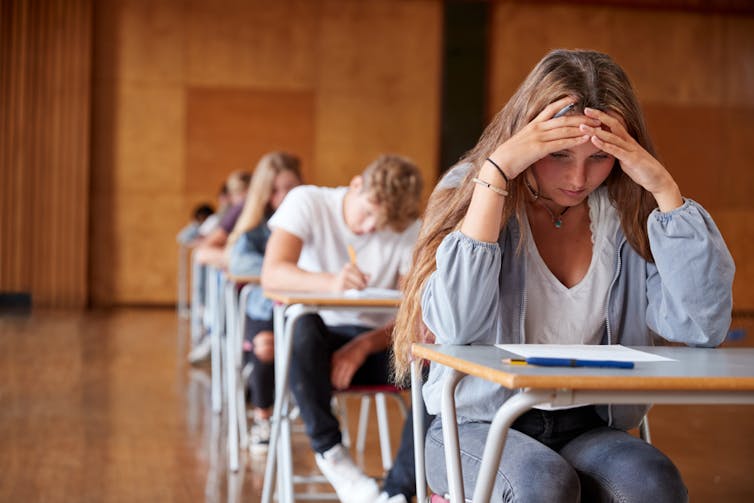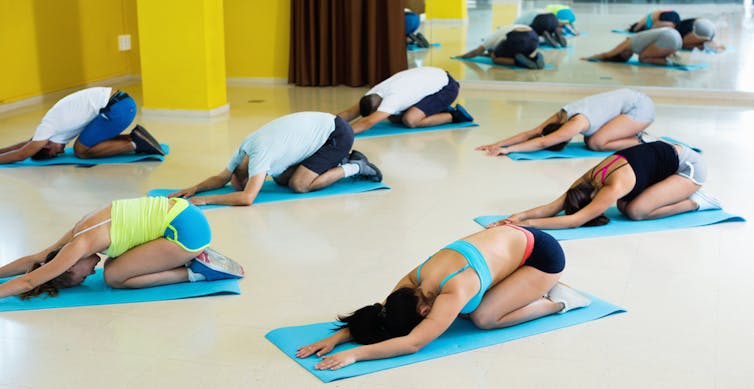Why we should put yoga in the Australian school curriculum
- Written by Michaela Pascoe, Postdoctoral Research Fellow in Exercise and Mental Health, Victoria University
This series draws on the latest research on back to school transitions. In it, the experts explain how best to prepare children for school, and counter difficulties such as stress or bad behaviour.
Young people in Australia experience very high stress in schools, which has negative impacts on their academic performance and mental health. It is crucial schools teach students how to identify and best manage stress. These skills will continue to benefit them throughout their lives.
Adolescence is a critical stage at which to intervene as health-related behaviours established during this period are often carried into adulthood.
School-based stress management programs, such as mindfulness based yoga programs, have been shown to be effective in the United States. Similar programs would benefit Australian school children.
Read more: What is mindfulness? Nobody really knows, and that's a problem
Australian school kids are highly stressed
Nearly half (47%) of Australian students feel very tense when they study, compared to the international average of 37%.
Based on the OECD average, 67% of Australian students report feeling very anxious even if well prepared for a test, compared to the international average of 56% (64% for girls and 47% for boys).
In the 50% of young people in years seven to 12 who report feeling moderately to extremely stressed over exams, the number one source of pressure comes from themselves. Coping with stress is a top issue of concern to young people.
The impact of school stress on young Australians and society
Drop out
School related academic stress and burnout decreases student academic motivation and increases the risk for dropout.
Australian early school leavers earn approximately A$27,500 less a year than school completers. People with higher rates of education report fewer illnesses and better mental health and well-being.
In 2014, there were almost 38,000 early school leavers aged 19, costing Australia A$315 million a year. Dropping out can also have wider social impacts, like repeated inter-generational problems of low academic outcomes, unemployment, poverty, less participation in the political process and contribution to the community.
Academic achievement
In Australia, students with low well-being are likely to have poorer academic achievement. Frequent positive emotions during class are associated with more student engagement, while negative emotions are associated with less engagement in years seven to ten.
Stress can also impair mental health which further reduces academic performance.
In high school, people experiencing depression symptoms have poorer educational achievement, concentration difficulties, troubles completing school tasks, and trouble with social relationships, self-learning, reading and writing as well as higher rates of risky behaviour.
 Stress is linked to poorer academic performance.
Shutterstock
Stress is linked to poorer academic performance.
Shutterstock
The impact of stress and poor stress management follows young people into higher education. In 83% of Australian TAFE and undergraduate students, the main factor affecting people’s studies was stress.
In US undergraduates, perceived stress and higher anxiety about exams translates to poorer final grades and academic performance.
Risky behaviour
Substance use has been shown to be a dominant stress management strategy in year 11 students in the US. In Canada, students who felt connected to their school report better health, higher self-worth, less anxiety and less likelihood of smoking, drinking alcohol and associating with peers who commit crimes.
Academic resilience and buoyancy increases the likelihood of success in school despite setbacks, stress or pressure in the academic setting. Resilient and buoyant students are able to maintain high levels of achievement, despite stressful events.
Schools can better support students with yoga programs
Schools can change educational policies and practices to address the needs of students at risk of academic failure. Student stress levels relate to how supportive they feel their teachers and schools are, rather than the number of school hours or the frequency of tests, according to an OECD survey.
The practice of yoga and mindfulness has become popular in recent years as a form of stress management in Australia. These practices decrease physiological markers of stress in diverse populations.
Read more: How yoga makes us happy, according to science
There is no definitive classification of yoga, but common elements are:
controlled breathing
meditative techniques
asanas (the physical yoga postures or positions)
mindfulness practice, which is the process of focusing awareness on the present moment and acknowledging and accepting feelings, thoughts, and bodily sensations, in a non-judgmental way.
 Studies show yoga improves self-image and management of negative emothions.
Shutterstock
Studies show yoga improves self-image and management of negative emothions.
Shutterstock
Mindfulness-based communication improves resilience in first-year college students, while students who take part in some moderate or vigorous physical activity are less likely to report they feel very anxious about schoolwork.
In high school settings, studies from the US and India show mindfulness based yoga programs can improve grades or mitigate decreases in grades across the school year, improve emotional regulation, improve memory, anger control and fatigue/inertia, improve mood and decrease anxiety.
A qualitative study showed yoga improves self-image and management of negative emotions and optimism. Students think yoga could reduce interest in the use of drugs and alcohol and increase social cohesion with family and peers.
At home, parents can consider practising mindfulness together with their kids, and can access a range of mindfulness and meditation online programs and apps for young people, such as through Headspace and Smiling Mind.
Given the evidence base, offering mindfulness based yoga programs in schools may help young people learn to manage stress and increase their ability to bounce back in response to stress.
Authors: Michaela Pascoe, Postdoctoral Research Fellow in Exercise and Mental Health, Victoria University
Read more http://theconversation.com/why-we-should-put-yoga-in-the-australian-school-curriculum-89962





